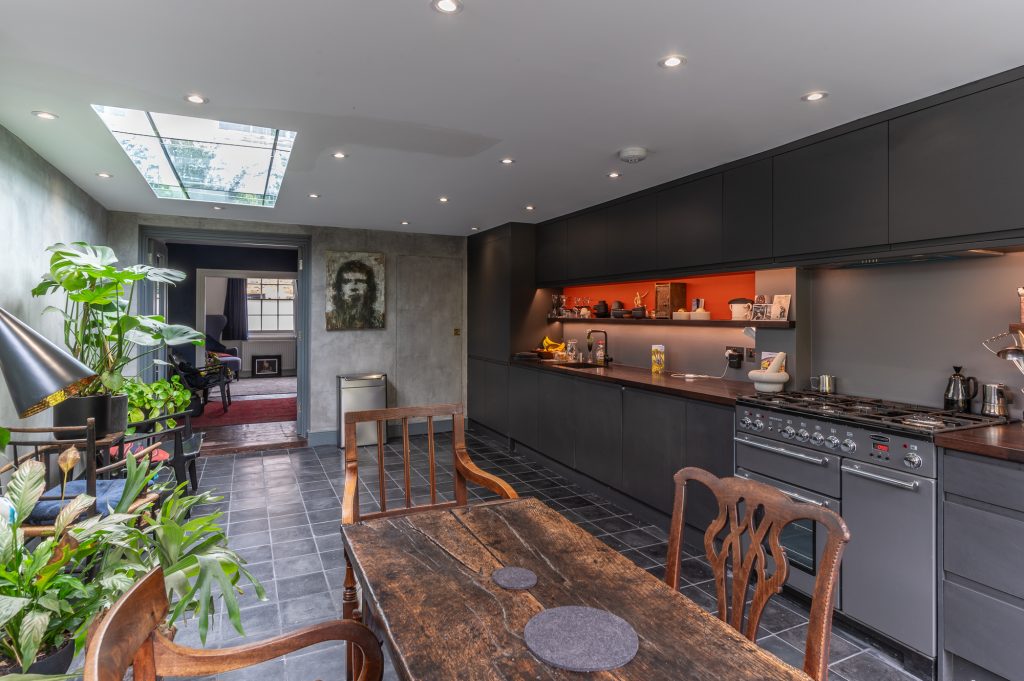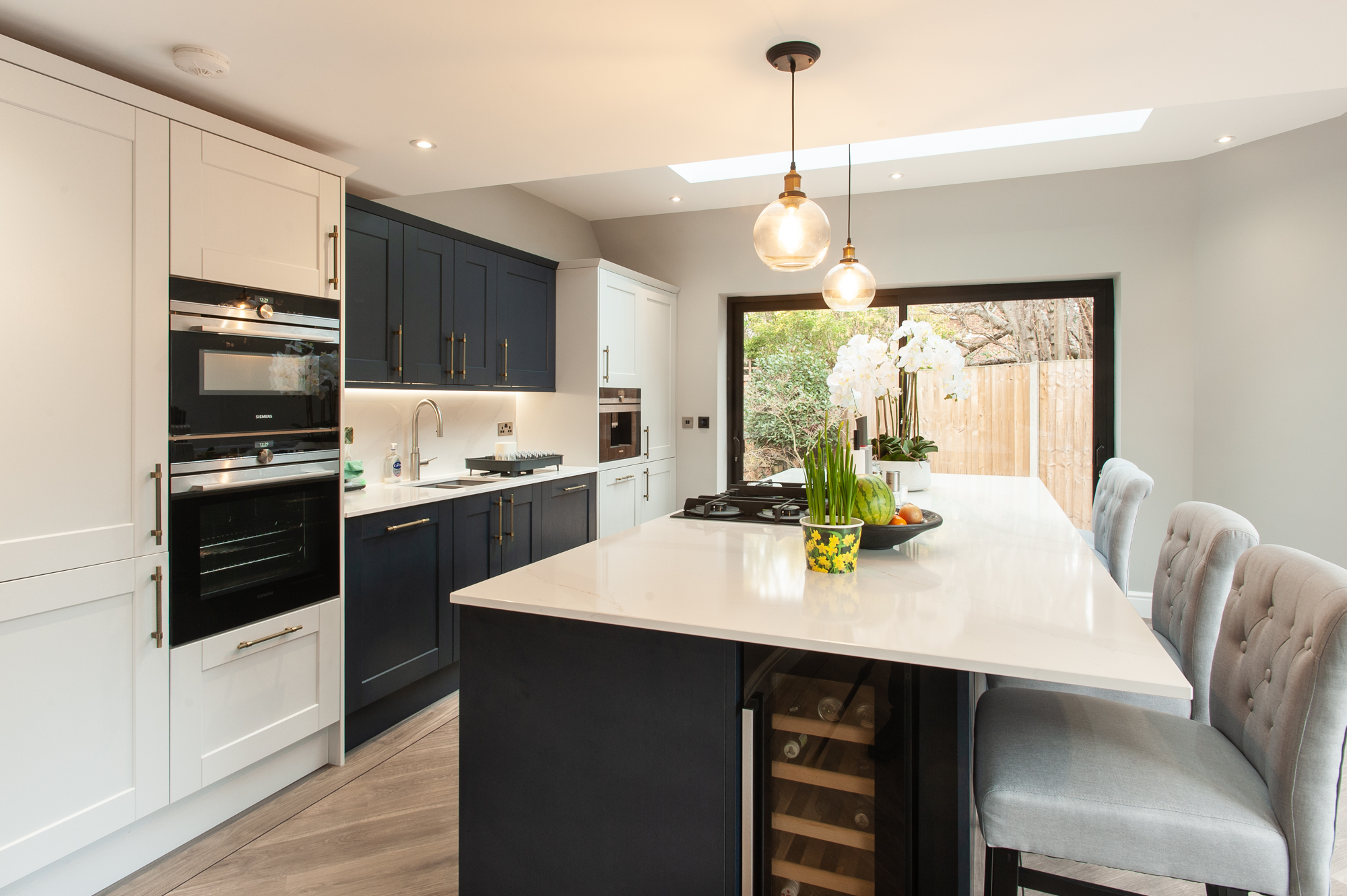Kitchen extensions have always been a popular choice for homeowners who want to expand their living space. But in crafting a kitchen extension that effortlessly blends with your existing home, attention to detail is paramount.
This involves careful consideration of various design elements, colour schemes, and functionality, to create a space that seamlessly connects the old and the new; ultimately creating an extension that not only expands your home but enhances its overall appeal.
And it all begins with planning. Where careful thought and incredible attention to detail lay the groundwork for a simply spectacular kitchen extension that blends functionality, aesthetics, and practicality into the heart of the family home.
Planning Phase
There is no such thing as too much planning when it comes to kitchen extensions. But one of the best ways to keep the extension aligned with your specific requirements is to focus on a few steps that ensure a successful and functional project. These include:
- Assessing your needs
Start by identifying your specific needs and goals for the kitchen extension. Consider factors such as the size of your family, cooking habits, entertaining preferences, and desired features. This will help guide the design process and ensure that the extension meets your lifestyle requirements.

- Creating a realistic budget
Determine your budget for the kitchen extension and establish realistic cost estimates for construction, materials, labour, permits, and even contingencies. Consider consulting with a professional to get accurate cost projections and prioritise features based on your budget.

- Planning out the space
Assess the available space for the extension and consider the layout options. Determine the optimal placement of key elements such as the kitchen work triangle (sink, stove, and refrigerator), storage areas, dining space, and seating areas. Consider factors such as traffic flow, accessibility, and functionality when designing the layout.

- Obtaining the requisite permits
Check local building codes, zoning regulations, and permit requirements for kitchen extensions in your area. Obtain the necessary permits and approvals from local authorities before starting construction to ensure compliance with building standards and avoid potential legal issues.
By incorporating these planning strategies, you can create a well-designed and functional kitchen extension that enhances your home’s living space and meets your lifestyle requirements.

Designing your Kitchen Extension
When building a kitchen extension, there are countless design ideas to consider that embrace creativity while enhancing functionality, aesthetics, and overall appeal. And while there is no one-size-fits-all, some of the best ways to begin designing your kitchen extension is by factoring in these crucial considerations:
- The Layout
Design the kitchen layout with ergonomics in mind to optimise workflow and functionality. Ensure that key elements such as the sink, stove, and refrigerator are positioned in a convenient and efficient arrangement, minimising unnecessary movements during food preparation and cooking.
You could also consider an open-plan layout that integrates the kitchen with adjacent living or dining areas. This design promotes social interaction and makes entertaining so much easier while maximising the use of available space.

- Natural Light
Maximise natural light in the kitchen extension by incorporating large windows, skylights, or glass doors. By considering the orientation of the extension and strategically positioning windows, it is possible to capture ample sunlight throughout the day. This not only enhances the aesthetics of the space but also reduces the need for artificial lighting during daylight hours.

- An Indoor-Outdoor Connection
Design the kitchen extension to create a seamless connection between indoor and outdoor living spaces. Consider features such as floor-to-ceiling windows, bi-fold or sliding glass doors, or a patio or deck extension to blur the boundaries between the interior and exterior. This allows for enhanced views and easy access to outdoor entertaining areas while creating a sense of continuity and expansiveness in the space.

- Storage Space
Plan for ample storage in the kitchen extension to keep the space organised and clutter-free. Consider incorporating a mix of cabinets, drawers, pantry space, and shelving to accommodate kitchen essentials, small appliances, cookware, and food items. Customised storage solutions can also maximise space utilisation and improve functionality.
For example, you could take advantage of vertical spaces by incorporating tall cabinets and shelving units. You could also consider floor-to-ceiling cabinetry or open shelving to create a visually striking feature wall while providing ample storage for kitchen essentials.
Alternatively, you could increase space efficiency by incorporating dual-purpose features and multifunctional furniture into the kitchen extension. Consider options such as built-in seating with hidden storage, pull-out pantry shelves, or fold-down tables that can be tucked away when not in use.

- Utilities
Ensure that the kitchen extension is equipped with essential utilities such as electricity, plumbing, and HVAC systems. Plan for the installation of kitchen appliances, sinks, faucets, and lighting fixtures, and consider the placement of outlets, switches, and ventilation vents to optimise functionality and aesthetics.

- Cohesive Design
Ensure that the design of the kitchen extension complements the existing architecture and style of your home. Choose materials, finishes, colours, and fixtures that harmonise with the rest of the property to create a cohesive and unified look.
If the kitchen extension is part of a period property or historic home, consider blending traditional architectural elements with modern design features. Elements such as exposed beams, brickwork, or reclaimed materials add character and charm while creating a contemporary living space.

- Statement Pieces
Add visual interest and personality to the kitchen extension by incorporating statement features such as a focal point backsplash, designer lighting fixtures, or a unique kitchen island. Consider using contrasting materials, textures, and finishes to create a dynamic and visually appealing space.
- Sustainability
Incorporate sustainable design principles into the kitchen extension, such as energy-efficient appliances and light fixtures, eco-friendly materials, and passive design strategies. Consider installing solar panels to generate renewable energy, rainwater harvesting systems to increase water efficiency, or energy-efficient windows to minimise environmental impact and reduce utility costs.

- Smart Technology
Incorporate smart technology and automation into the kitchen extension to enhance convenience, efficiency, and connectivity. Install smart appliances, lighting systems, and climate control devices that can be controlled remotely as a means of avoiding energy waste.

- Customisation
Tailor the design of the kitchen extension to suit your lifestyle and specific needs. Consider features such as a built-in coffee station or a designated baking area to enhance functionality and cater to your preferences.
The kitchen extension should also be a reflection of your unique style. This could mean the integration of modern minimalism or classical charm, luxurious finishes or colourful accents, or even the incorporation of sentimental touches.
You could also embrace a biophilic design that further enhances your connectivity with the outdoors.
- Professional Help
Easily the most effective strategy to design the perfect kitchen: ask the experts!
Consult with an experienced architect, interior designer, or kitchen specialist to help realise your vision for the kitchen extension. They can provide valuable insights, expertise, and creative solutions to ensure that the design meets your aesthetic preferences, functional requirements, and budget constraints.

By incorporating these fundamental planning and design ideas, you can create a stylish, functional, and inviting space that expands your home, enhances your living experience, and adds incredible long-term value.
Looking to plan, design, and create the perfect kitchen extension? Look no further than Good Design and Build! We offer an all-inclusive solution, from design to construction. Check out our recently completed projects, get inspired, and start your journey towards your dream home today!




